LWRCI is a recognized industry leader in the development and manufacturing of short-stroke piston operating ARs. LWRCI’s entire reason d’être is the short-stroke piston and the improvement it offers over the original gas impingement design – especially when incorporated into short barrel platforms. It is no secret that the AR is not only the best selling civilian and law enforcement rifle in the U.S., but also gaining popularity around the world with the U.S. equipping/training so many armed entities. This has caused many manufacturers to jump on the AR bandwagon in recent years by offering their versions. Of late, the most attention seems to be on “improving” the AR platform via developing piston-driven ARs in lieu of Stoner’s original gas impingement design. Whether or not piston-driven ARs are superior to their gas impingement brethren often generates heated discussion. One thing that is not debatable is the number of manufacturers rushing to create piston-driven ARs even if traditional AR models already exist in their production line-up.
LWRCI offers numerous models ranging from LE/military-only select-fire versions, various barrel lengths/profiles ranging from 7-inch barrel UCIW model to 18-inch barrel M6A3 DMR. Other unique models include the M6A4 IAW that fires from a closed bolt on semiautomatic then goes to open bolt function on automatic fire and then ultimately the 7.62×51/308Win REPR. The REPR is quickly finding favor in U.S. law enforcement and military special operation communities. Another LWRCI model, and the one focused on in this article, is the PSD – Personal Security Detail. The PSD is one of LWRCI’s smallest, dimensionally speaking, contributions to the AR field. A LWRCI PSD upper was obtained for testing in lieu of a complete rifle. The flexibility of the AR platform is hard to beat considering one moment an 8-inch barrel PSD upper is fitted to NFA registered lower – if a civilian or LE – and the next an 18-inch heavy barrel DMR upper is installed if mission dictates it. This does not even get into the myriad of calibers that are coming on line for the AR ranging from 5.7 to .50 Beowolf with many stops in between.
LWRCI literature clearly lays out the thought process behind the development of the PSD. The 8-inch barrel PSD 5.56mm is designed for CQB and personal security detail (PSD) operations. It is best to view the 8-inch barreled PSD through the lens of a PDW or SMG weapon versus a rifle. The 8-inch barrel produces approximately 2,400-2,500 fps velocities when firing 50gr-62gr 5.56mm loadings. The PSD is also available in 6.8 SPC chambering; in fact it was the original chambering in the PSD product line. However, the decision was made to also chamber the PSD in 5.56mm based improvements in the 5.56mm cartridge in terms of bullets and powders. This re-evaluation is based on 5.56mm performance being greater than any pistol caliber combined with the compact dimensions of the LWRCI PSD rivaling a SMG. It only made sense from a business standpoint considering the vast number of individuals, departments, agencies, and units intimately familiar with the 5.56mm round and existing number of magazines/ammunition already in the supply chain.
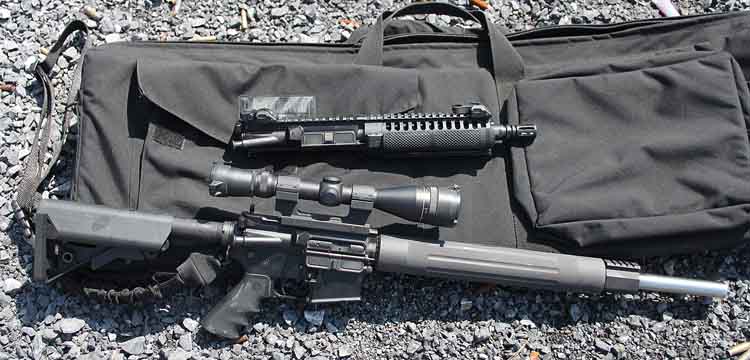
The PSD utilizes LWRCI’s patented self-regulating, short-stroke gas piston operating system, ensuring reliability in the harshest theaters of operation. LWRCI literature points to several industry leading technological innovations incorporated in the PSD. LWRCI has sought to engineer a complete solution to the deficits found in the direct impingement AR family of rifles and carbines and was an early innovator in the AR gas-piston surge. The principal improvement comes from eliminating the venting of hot, carbon-laden gases into the receiver and bolt carrier group. This reduces the cleaning requirements associated with direct gas impingement ARs. It also means the bolt carrier group and associated springs are not subjected to the searing heat of the tapped gasses; this being one of the major causes of small parts failure. The LWRCI PSD utilizes cold hammer forged barrels made out of 41V45 steel alloy and treated with NiCorr surface conversion technology. NiCorr surface conversion has proved more lubricious, harder wearing, more heat and corrosion resistant than the hard chrome-lining normally used in a service rifles’ bore. LWRCI advertises its barrels as being able to handle 20,000 rounds before replacement, as compared to 6,000-10,000 rounds with standard chrome lined barrels. The bolt carrier of the PSD is coated with a proprietary nickel coating that nearly eliminates corrosion while providing greatly increased lubricity. This coating provides permanent lubrication to the moving parts and is similar to that being used by the U.S. Army Research Lab and USSOCOM to extend the service life of their weapons systems.
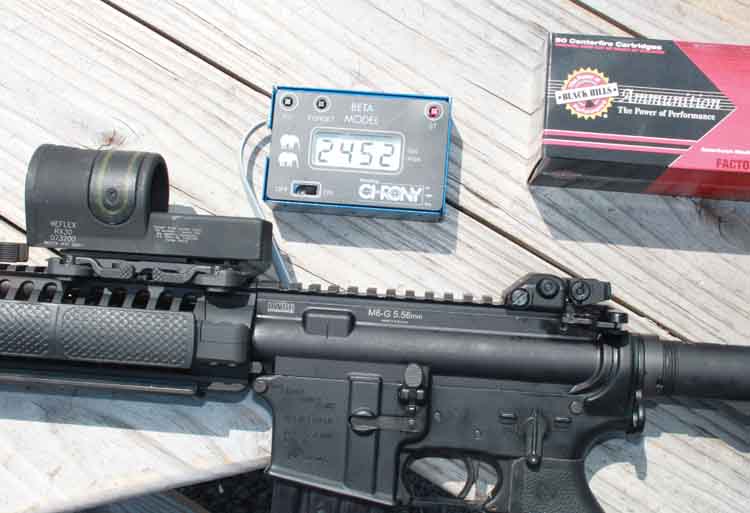
The PSD’s ARM-R forend’s top rail is easily removable and reinstalled without effecting zero of any sights or target designators. Cleaning methods for the LWRCI are familiar to anyone with experience with the AR-15 with the operating rod mechanism easily accessed thanks to ARM-R design. The ARM-R rail allows for mission specific configuration with lights, lasers, target designators, and other items. As benefiting a rifle in the PSD’s price range and intended LE and military audience, the PSD comes standard with folding BUIS open sights that proved able to co-witness with a variety of optics mounted on the PSD. The PSD upper installed on a lower weighs slightly over 6 pounds and has an overall length of 24.5 inches with LMT SOPMOD stock collapsed and approximately 28 inches extended. The LMT SOPMOD is a favored stock type and the type affixed to lower mated with LWRCI PSD upper for a large portion of this T&E. The PSD’s 8-inch barrel features 1:7 twist and comes with an A2 style flash hider. The 8-inch barrel maximizes portability and handling while maintaining a ballistics and terminal performance superior to any pistol caliber carbine or SMG.
The key with the LWRCI PSD is having an 8-inch barreled AR that works at the same reliability level as longer barrel ARs. This is where the LWRCI short-stroke piston comes into play. Instinctually, piston driven ARs appeal too many by the very fact that hot gases and powder residue is not dumped into the action as in the original direct impingement (DI) design. Hands on experience of LWRCI bolt carrier being handled soon after long strings of fire and merely wiped down compared to their DI cousins reinforces this. The ability of the gas piston ARs to operate with barrel lengths below the generally accepted 14-inch barrel threshold of DI ARs reliability adds further legitimacy to the piston ARs. Do not take this as lampooning of the gas impingement ARs. The DI rifles are more robust than most give them credit for and sub-14 inch barreled rifles are possible with attention to detail by the manufacturer in terms of gas port sizes and timing of the ejection process.
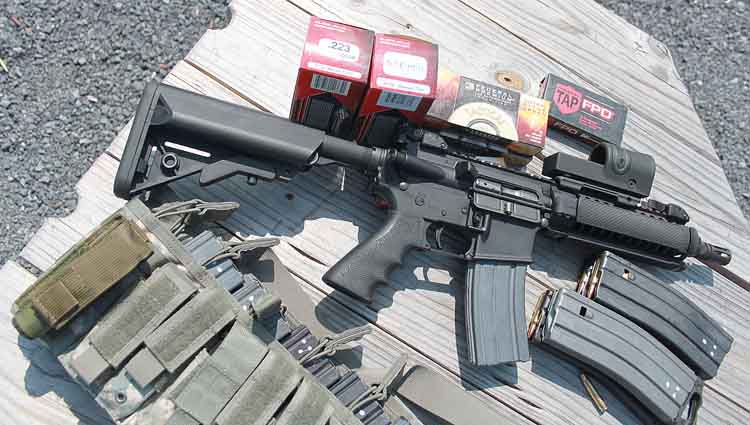
LWRCI utilizes a piston design made up of three components. A piston cup fits over the gas plug located at the front of the PSD handguard with an intermediate rod placed between the piston cup and operating rod that acts on the bolt carrier group. The LWRCI push-rod system is self cleaning in that any excess gas is vented out of the handguard just behind the gas block. The gas cup has grooves that act as scrapers as the action is worked to prevent carbon build up in the gas cup. The rear of the gas-piston rod is what smacks against the bolt assembly’s integral strike plate operating the action. LWRCI’s pioneering work with the AR piston system has led to the use of an integral strike plate in lieu of a staked version. This is based on concerns of metal fatigue and not wanting to take the chance of a staked strike plate failing. Along these same lines the LWRCI’s bolt body features radial grooves that serve multiple functions; such as anti-tilt for the bolt assembly along with providing a certain amount of built-in tolerance against any debris that may find its way into the LWRCI’s action and buffer tube area. LWRCI’s short-stroke piston use of a “tappet” system to impart force to the piston driving the bolt carrier to the rear minimizes heat build up not only in the weapon’s action, but also along the weapon’s forend due to gas being confined to the gas plug/piston cup located behind the gas block; thus preventing hot gas from transmitting down the length of a gas tube ala direct impingement or long-stroke operating method.
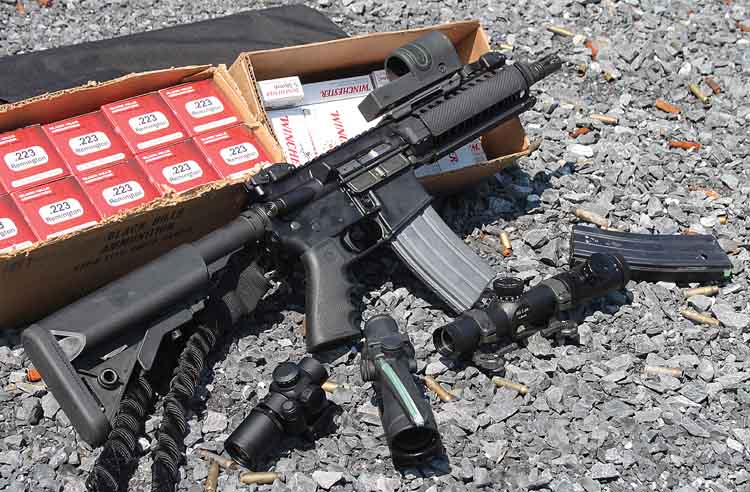
C.R. Newlin, Echo Valley Training Center owner, generously allowed access to his select-fire AR lower for testing with the LWRCI PSD upper supplementing a registered semi-only lower already on hand. Range testing commenced with functionality test consisting of dumping multiple magazines at several targets in rapid fashion once sight zeros were verified. Any fighting rifle must be reliable to be worthy of further consideration. The importance of quality magazines can not be overstated in terms of impacting a weapon’s reliability. The majority of malfunctions in a select fire, or even semi-auto rifle, can be traced to a faulty magazine. Brownells’ AR magazines are primarily used for most T&Es for this reason, though random magazines are mixed into testing at times. The LWRCI’s short-stroke gas piston operating rod system proved its worth in keeping the bolt carrier group cooler and cleaner compared to direct impingement AR rifles. While not trying to be unrealistic or overly harsh, the LWRCI PSD was exposed to multiple magazine dumps at various times of the T&E. The method was not mindless ammunition wasting, but rather wanting to confirm beyond a doubt that the PSD delivered as advertised under the most extreme circumstances of operational functioning. It was quickly noticed how little heat was transmitted not only to the PSD’s action, but also into the PSD’s quad rail forend with shooters able to grip the weapon without resorting to gloves or installing a vertical forward grip. Anyone with experience with AKs or direct impingement ARs know how fast forends can heat up with only a few magazines worth fire.
It was decided to take full advantage of the PSD’s flattop upper by accessing multiple optics for use during testing. A Trijicon RX30 Reflex was mounted on the PSD with it sharing time with a Leupold Prismatic. A Hi-Lux/Leatherwood Optics CMR 14×24 was also employed to ascertain the PSD’s accuracy potential via 4x magnification capability. The CMR scope was designed for when a shooting situation gets up close and personal. The CMR (Close Medium Range) has 1x-4x magnification based on a compact 30 mm tube. The relatively short 30 mm tube scope does not add a lot of weight to the rifle, and thanks to the large diameter of the scope tube, it lets in a lot of light for a bright target image. Hi-Lux/Leatherwood literature points out, “…an extremely practical circular reticle that aids in quick target acquisition by drawing the attention of the shooter’s eye to the center of the scope. Along these same lines, to insure that the target is fully visible, the reticle has only a horizontal crosshair, with a partial vertical lower crosshair. The upper half of this reticle leaves the scope clean and uncluttered. Plus, the lower crosshair features short bar aiming points calibrated for standard .223 and .308 service ammo, which are very precise out to 600 meters. The center dot and the small circle of the reticle are available with either green or red illumination.” It was discovered that the PSD’s rear flip-up sight had to be removed to provide clearance for the CMR to mount properly, which would be a negative for many considering the PSD’s likely CQB role in the field.
The optic types intended to be left on the LWRCI PSD after accuracy testing would be the Trijicon RX30 Reflex or Leupold Prismatic; though some may be inclined to leave the Hi-Lux/Leatherwood CMR mounted. The Trijicon RX30 and Leupold Prismatic sight offer the capability to engage multiple targets in rapid sequence compared to open sights, while at the same time providing adequate accuracy out to a couple hundred yards. As many “maturing” shooters can attest to, a single focus plane is easier to shoot accurately than coordinating front and rear sights. The 5.56/.223’s flat trajectory aids in making hits out to 250 yards without having to compensate excessively for bullet drop even with the short 8-inch barrel.
A 150 yard zero provides for +2 inches at 100 yards, -5 inch at 200 yards, and -13 inches at 250yds.
The PSD was evaluated at Echo Valley Training Center (EVTC). EVTC is fast becoming a major provider of training on the East Coast with multiple organizations conducting courses onsite. The private facility has multiple 100 yard bermed enclosed bays capable of handling numerous students conducting “square” range drills or more dynamic/fluid types of training. In conjunction with the individual training bays, Echo Valley Training Center features multi-stepped target berms that are strewn with reactive steel MGM targets, fluid drained automobiles, and moving targets at ranges varying from 150 yards out to 350 yards.
Ammunition tested with the PSD was a combination of Black Hills Ammunition 55gr FMJ and 50gr TSX, Winchester Ammunition 55gr FMJ and Federal Premium Law Enforcement 55gr Triple Shok and 62gr Bonded SP loads. Loads evaluated chronographed between 2,400-2,500 fps; which was a pleasant surprise considering the short PSD barrel. The PSD kept all loads tested at 1 inch or better at 50 yards with the Federal Premium 55gr Triple Shok and Black Hills 50gr TSX producing near MOA groups out to 200yds. Overall, the accuracy level was more than acceptable considering the barrel’s profile. Most bulk range firing utilized the Winchester and Black Hills Ammunition 55gr FMJ. Ammunition such as the Black Hills 50gr TSX and Federal 55gr Triple Shok and 62gr Bonded loads elevate 5.56mm terminal ballistic performance and barrier penetration across the board; especially in short barreled rifles such as the PSD.
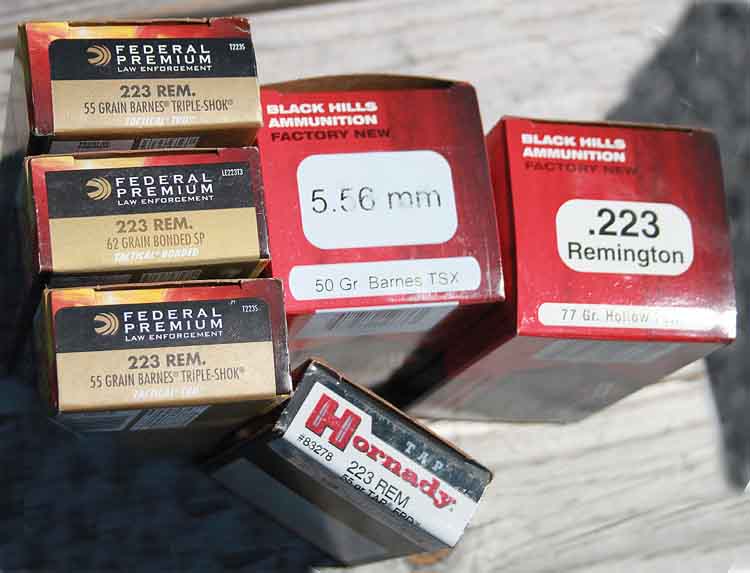
AR ergonomics are hard to beat even on a full size AR with the compact PSD even handier and easier to wield in tight quarters. Drills moving around barricades and training evolutions involving firing and evacuating from vehicles clearly bore this out. A short barrel rifle like the LWRCI PSD is what individuals will choose to work with in such an environment where the trade off in size is worth any loss in bullet performance due to reduced velocity. Prior training experiences with Suarez International, Tactical Response, and Storm Mountain assisted in providing a baseline foundation of what qualities are desirable in a fighting rifle along with proofing ancillary gear such as BlackHawk chest rig for carrying magazines and BlackHawk single-point sling in case the PSD needs to be slung freeing up use of both hands. The PSD’s performance is superior to any SMG and it does not take a backseat to full-size rifles in the sub-200 yard arena, which is what was what the PSD was designed for by LWRCI.
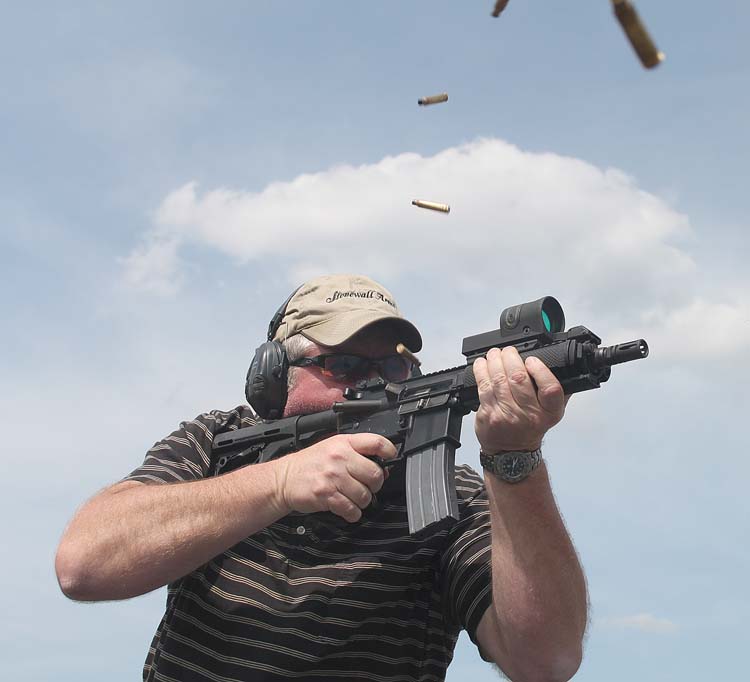
Sites of Interest
LWRC International, LLC
Cambridge, MD. 21613
Phone: (410) 901-1348
www.lwrci.com
Leatherwood/Hi-Lux Optics
3135 Kashiwa St
Torrance, CA 90505
Phone: (310) 257-8142
www.hi-luxoptic.com
Black Hills Ammunition
PO Box 3090
Rapid City, SD 57709
Phone: (605) 348-5150
www.black-hills.com
Leupold & Stevens Inc
14400 NW Greenbrier Pkwy
Beaverton, OR 97006
Phone: (800) LEUPOLD
www.leupold.com
Echo Valley Training Center
251 C Prosperity Drive
Winchester, VA 22602
www.echovalleytrainingcenter.com
Trijicon Inc.
49385 Shafer Ave
Wixom, MI 48393
Phone: (248) 960-7700
www.trijicon.com
ATK/Federal Cartridge Company
900 Ehlen Drive
Anoka, MN 55303
Phone: (800) 322-2342
www.federalpremium.com
Winchester Ammunition
427 N. Shamrock St
East Alton, IL 62024
www.winchester.com
Lewis Machine & Tool, Inc
1305 11th W
Milan, IL 61264
Phone: (309) 732-9527
www.lewismachine.net
| This article first appeared in Small Arms Review V15N4 (January 2012) |










